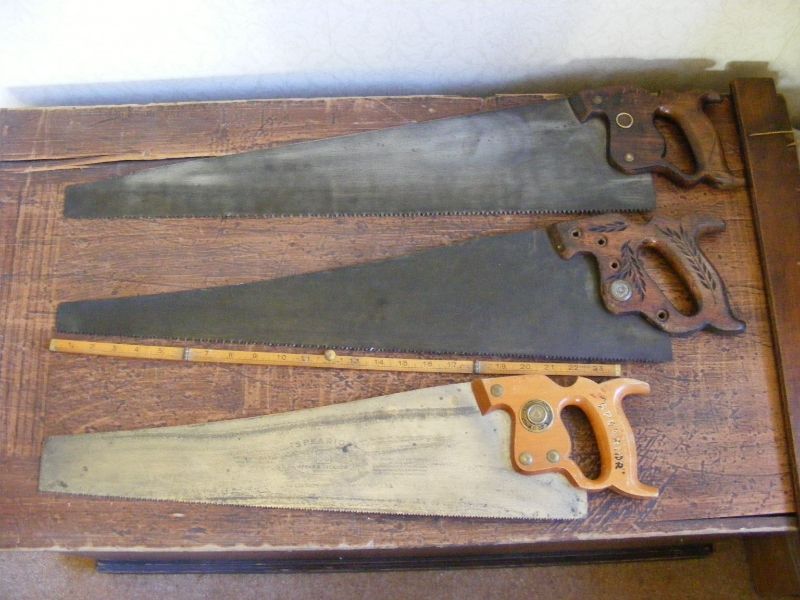Hi Chaps,
I've recently picked up some hand-saws cheap on ebay - mostly for more saw sharpening practice but also with the aim to kit out a tool chest and replace my plastic handled saws - and I'm debating how I should go about sharpening them. I've been trying to pick up a rip-saw and two of them (top two in the picture, below) were listed as such but on inspection they look like cross-cut. So I've ended up with three saws, all of which look to me like cross-cut. I'm wondering if I can file any to work as a rip-saw, and, if I can, which is the best candidate.
The three saws:
- Saw 1 (top). Jackson saw from the Keystone Saw works. 5tpi, 26 1/2" blade with a rake ranging from 12-20 degrees across the teeth, and not much fleam.
- Saw 2 (middle). Unnamed saw, but the medallion reads 'Warranted Superior' with a Keystone symbol. 6tpi, 26" blade with a rake of about 18 degrees, and a fair bit of fleam. Currently very blunt. This one's got a fairly big handle, with enough space to fit the thumb of my left hand though which I understand can help with ripping?
- Saw 3 (bottom). Spear and Jackson "Spearior" 88. 9tpi, 22" blade with 18-22 degrees rake and filed at an angle for cross cutting.
So, is it possible to re-file one of these and adjust the rake to make it more suited to rip cutting (which I understand to be 0 - 8 degrees) simply by holding the file in a jig set at the correct angle? If that is possible, which of the above saws is the best candidate for a rip saw? (1 has the better teeth, but 2 has the better handle to my mind).
Could I even get away with keeping the relaxed rake angle (gradually improving it if possible) but filling straight across for no fleam, or will not serve/cut-slowly when rip-cutting?
And - as a slight aside - I have two books here that comment on the best type of saw to own if you only have one saw. Chris Schwarz suggests getting a rip-saw first as it can be made to cut cross-grain and just requires more cleaning up, whilst Charles Hayward recommends a single cross-cut saw first which he claims can be used to cutting with and across the grain. Are either of these approaches 'right or wrong', or do both approaches leave you with a saw that can be forced to do either job, but isn't ideal for one of them? I'm planning to make a smallish Dutch style tool chest, which will only fit a shorter saw, and I'm hoping the Spear and Jackson cross-cut saw will fit that purpose.
Apologies if I've mixed up any of the terminology - my confusion on some points may be apparent in the (possibly foggy) wording of my questions!
Any help much appreciated,
Duncan





 Reply With Quote
Reply With Quote

